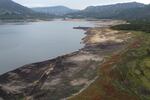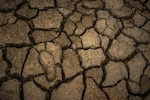
The San Rafael reservoir on the outskirts of Bogotá, Colombia, has been drying up since a long spell of dry weather began in November and is currently just 16% full. Officials in the Colombian capital started to ration water in April to help local reservoirs recover.
Manuel Rueda for NPR
Steven Ramos runs a coffee shop outside Externado University in Bogotá.
But last week there was no running water in his neighborhood, so Ramos couldn't use his espresso machine.
Instead, he made filtered coffee for his customers using bottled water he bought at a supermarket.
"Many people aren't going to their offices or to the university on the days without water," he says. "So my sales are suffering."
A drought, brought about by the El Niño weather pattern, has upended life in several South American cities this year, with consequences that include water rationing and power cuts as well as forest fires.
Colombia's capital city of Bogotá is built on a green plateau high in the Andes Mountains, and is usually a rainy place.
Related: Warm Oregon winter could persist well into the new year
But a long spell of dry weather that began in November has depleted the reservoirs that the city depends on for its tap water, leading officials to ration water in the city of 8 million people for the first time in decades.
"It's been very dry and very hot," says Natasha Avendaño, the general manager for Bogotá's municipally owned water company, known by its Spanish initials EAAB. "Both things have led us to have higher levels of evaporation of water in both our dams."
Cut back on showering
Bogotá's main reservoir went from half capacity in September to being just 16% full last week, according to data published by the city's government.
To reduce water consumption and enable it to recover, authorities divided the city into nine areas, that are cut off from the water supply on a rotating basis, for 24-hour periods.
Officials are also asking people to change their habits, with radio ads that tell people to limit their showers to three minutes and fines for those who conduct activities that are deemed to be wasteful of water, like washing cars in the streets.

Steven Ramos makes filtered coffee using bottled water on Wednesday April 24. Ramos runs a small coffee shop in Bogotá, but he cannot use his espresso machine when water is cut off in his neighborhood.
Manuel Rueda for NPR
Since the water rationing began on the second week of April, the city's mayor Carlos Fernando Galán has also urged people to refrain from taking a shower if they are not going to leave their house. Last week he urged apartment buildings in the city to turn off their large water tanks.
"We can't only depend on the rains coming back," Galan said in a press conference, where he provided updates about the water crisis. "We have to cut back on our consumption by changing our behavior."
Climate experts say the dry weather in Bogotá and much of Colombia is due to warming temperatures in the Pacific Ocean — which are known as El Niño events.
This weather pattern happens every two to seven years and it can have drastic effects around the world, especially in South America, says Andrea Devis, an oceanographer in Bogotá's Rosario University.
"During El Niño, we have a lot of rain along the Pacific [coast]," she says. "But on the other side of the Andes, we don't have any rain."
Related: Portland’s warm week could break 30-year record, but it won’t last long
El Niño has caused havoc in other countries
The current El Niño event began last June — and it has caused trouble in several countries.
In Chile, dry weather contributed to forest fires in February that spread into the city of Viña del Mar, and killed more than 130 people.
And in Ecuador, officials declared a state of emergency on April 19 and began to ration electricity because of the lack of rainfall.
More than 78% of Ecuador's electricity came from hydroelectric plants last year, but the drought has diminished their potential.
In the capital city of Quito, most homes and businesses were cut off from the power grid for eight hours each day last week — and traffic lights aren't working.
The power cuts have disrupted output at large and small businesses alike.

A footprint on a dry section of reservoir at El Guavio Reservoir on April 18, in Gachalá, Colombia. Reservoirs around Colombia are at low water levels due to a major drought caused by El Niño.
Diego Cuevas / Getty Images
"We've had to cancel many appointments because the power cuts are unpredictable," says Kelly Cuenca, a cosmetologist who works with hair removal machines at a beauty salon in Quito. "We rented a small generator but it only lasts a couple of hours."
Oceanographer Devis says that the power cuts show that governments in the region need to do more to prepare for drastic weather.
"We have to start thinking about other sources of electricity" like wind, solar and also tidal energy, Devis says.
As temperatures rise around the world due to growing carbon emissions, El Niño events are also likely to become stronger, and could lead to more intense droughts, Devis says.
Related: It’s the warmest September on record thanks to El Niño and, yes, climate change
And that means governments will also have to invest in pipelines to take water from places where it's plentiful to where it's scarce.
"We have places with a lot of water, and we have places that are suffering from extreme droughts," Devis says. "We need to think about how we can redistribute our resources in the best way possible."
Carolina Loza contributed to this story from Quito, Ecuador.
Copyright 2024 NPR. To see more, visit https://www.npr.org.


